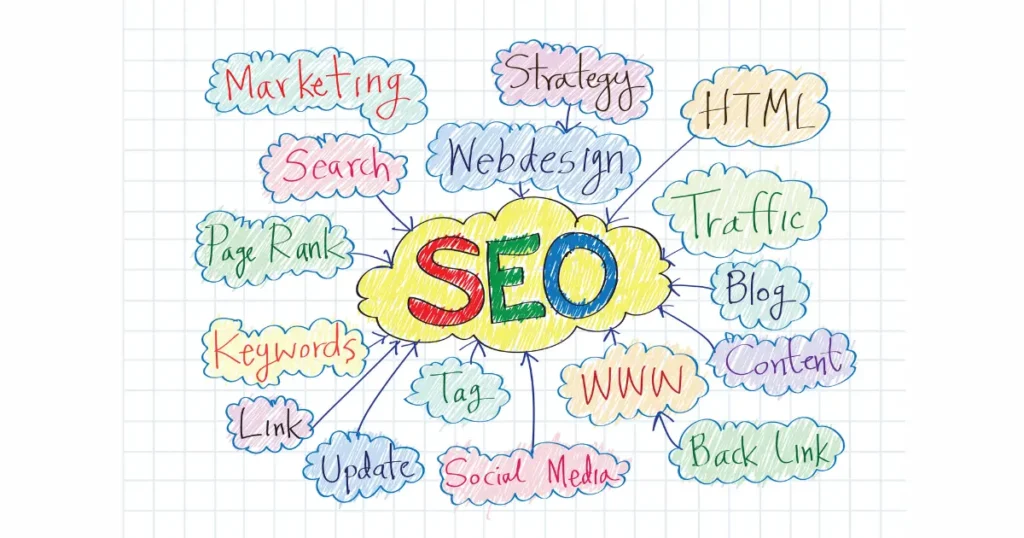
Running a local business in 2025 means competing not just with the shop down the street, but with every business that shows up when someone searches “best [your service] near me.” If you’re not showing up on that first page of Google, you’re practically invisible. That’s where on-page SEO for local businesses becomes your secret weapon.
Think about it: when was the last time you scrolled to page two of Google? Exactly. Your potential customers aren’t doing that either. They’re clicking on the first few results they see, and if your business isn’t there, you’re losing customers to competitors who might not even be better than you; they’re just more visible online.
In this guide, we’re breaking down everything you need to know about on-page SEO for local businesses. No confusing jargon, no complicated theories, just practical, actionable strategies that will help your business get found by customers in your city who are ready to buy.

What Is On-Page SEO for Local Businesses?
On-page SEO for local businesses involves optimizing elements directly on your website to help search engines understand what your business does, where you’re located, and why local customers should choose you. This includes page titles, meta descriptions, content, images, internal links, and site structure.
Unlike off-page SEO, which relies on external factors like backlinks, on-page SEO is fully within your control and can start improving your local search rankings immediately. The aim is to clearly show both search engines and visitors that your business serves their area and addresses their specific needs.
At Techdella, we’ve helped numerous local businesses boost their online visibility through effective on-page SEO. One client reported a 4X increase in store walk-ins after our optimization, highlighting that proper on-page SEO doesn’t just drive more website traffic, it brings real customers to your door. Done well, it creates a seamless experience that turns local searchers into loyal customers.

Why On-Page SEO for Local Businesses Matters More Than Ever
On-page SEO for local businesses is about attracting the right visitors, people nearby who are actively searching for the products or services you offer and are ready to take action. It’s not about global traffic; it’s about reaching customers in your neighborhood who can walk through your door or call you immediately.
Local searches have surged, with people often using their phones to find services like “coffee shop near me” or “emergency plumber in [city name].” Optimizing your on-page SEO for these queries puts your business in front of customers with high intent, and because you’re competing primarily with other local businesses, even a small budget can help you outrank larger competitors.
Key On-Page SEO Strategies for Local Businesses
To stand out in local search results and attract nearby customers ready to take action, focus on these essential on-page SEO strategies tailored for local success.

1. Optimizing Your Title Tags and Meta Descriptions for Local Search
Your title tags and meta descriptions act as your business’s storefront on Google, giving potential customers their first impression of what you offer and where you are. For effective local SEO, include your primary keyword, city or service area, and business name in the title tag, such as “Emergency Plumbing Services in Dallas | ABC Plumbing.” Keep titles between 50–60 characters to ensure they display fully in search results.
Your meta description should build on the title by adding a clear reason to click, naturally blending in your location and services within 150–160 characters. Avoid using the same title tag for every page.
Instead, create unique, descriptive titles for each page, whether it’s your services, contact, or location pages, so each one targets relevant local keywords and attracts the right audience.
2. Creating Location-Specific Content That Ranks
Content is the heart of on-page SEO for local businesses. It’s not about cramming in keywords but about creating helpful, relevant content that connects with your local audience. Build dedicated location pages for each area you serve, ensuring each one has unique descriptions of your services rather than duplicated text with just the city name changed. Google recognizes duplicate content, so originality is key.
Blog posts are also valuable, covering local events, news, and city-specific guides. For example, a landscaping business in Phoenix could write about “Best Drought-Resistant Plants for Phoenix Gardens” or “How Phoenix Weather Affects Your Lawn Care Schedule.” Your homepage should instantly tell visitors and search engines what your business does, where it operates, and who it serves.
At Techdella, we create SEO-optimized blogs and web content that blend local keywords naturally while providing real value. Our content strategies go beyond simple optimization; we help your brand stand out as the trusted local authority in your field.
3. Mastering Header Tags and Content Structure
Structuring your content properly plays a key role in on-page SEO for local businesses. Header tags (H1, H2, H3, etc.) help search engines understand your content’s hierarchy while making it easier for visitors to read and navigate.
The H1 should be your main headline and include your primary keyword and location, while H2 tags organize main sections and H3 tags break those into smaller subsections.
For instance, a dentist’s service page might use an H1 like “Comprehensive Dental Services in Austin, Texas,” followed by H2 headers for “Preventive Dental Care,” “Cosmetic Dentistry,” and “Emergency Dental Services.” This clear structure not only boosts SEO but also improves user experience by allowing visitors to quickly grasp what your business offers.
4. Optimizing Images for Local Search and Page Speed
Images are more than just visual elements, they are key to on-page SEO for local businesses. Use descriptive file names and alt text with relevant keywords so search engines can understand your content.
For example, a restaurant image should be named something like “italian-restaurant-pasta-dish-chicago.jpg” with alt text such as “Fresh homemade pasta served at Mario’s Italian Restaurant in Chicago” to boost visibility in image search results.
Optimizing images also improves page speed, a major factor in local SEO rankings. Compress images and use modern formats like WebP to maintain quality while reducing load times.
Mobile optimization is essential, as most local searches occur on smartphones, so images must load quickly and display correctly across all screen sizes.
5. Implementing Schema Markup for Local Business
Schema markup acts as a translator between your website and search engines, providing structured information about your business such as name, address, phone number, hours, services, and reviews.
For local businesses, using the LocalBusiness schema is particularly effective for on-page SEO, helping your site appear in rich results that showcase star ratings, business hours, and other key details directly in search results.
Implementing a schema doesn’t require coding expertise. Tools like Google’s Structured Data Markup Helper or WordPress plugins make it easy to add, as long as the information matches what’s visible on your site.
Common types for local businesses include LocalBusiness (or more specific types like Restaurant or DentalClinic), review schema, FAQ schema, and breadcrumb schema, each enhancing your visibility and helping your business stand out in search results.
6. Optimizing Your NAP (Name, Address, Phone) Consistency
Your NAP (Name, Address, and Phone number) needs to be identical everywhere it appears online. This might sound simple, but inconsistent NAP information is one of the most common mistakes that hurt local SEO performance.
Make sure your business name is exactly the same across your website, Google Business Profile, social media, directories, and any other online mentions. Don’t use “John’s Bakery” on one site and “John’s Bakery LLC” on another, even if both are technically correct.
Your address should be formatted consistently, too. Don’t abbreviate “Street” as “St.” in some places and spell it out in others. Your phone number should use the same format everywhere, either (555) 123-4567 or 555-123-4567, not both.
Display your NAP prominently in your website footer and on your contact page. This makes it easy for search engines to find and verify your information, and it helps customers quickly find your location and phone number, no matter what page they land on.
7. Creating Internal Links That Boost Local Relevance
Internal linking, which involves connecting one page on your website to another, is a key but often overlooked part of on-page SEO for local businesses. When done strategically, it helps search engines understand your site structure, distribute page authority, and highlight your most important pages. Use descriptive anchor text when linking from your homepage to service or location pages, for example, “our emergency plumbing services in Dallas” instead of generic phrases like “click here.”

Blog posts should also link to relevant service pages and related content to keep visitors engaged longer and guide them toward actions such as requesting a quote or booking an appointment.
Avoid overdoing it; a few natural, well-placed links per page are sufficient. The main goal is to create a logical flow that helps users find what they need while signaling to search engines how your pages are connected.
8. Mobile Optimization for Local Search Success
Mobile optimization is critical for local business SEO because Google uses mobile-first indexing, meaning it evaluates your site’s mobile version for rankings. A fast-loading mobile site, ideally under three seconds, is essential, as even slight delays can hurt conversions. Tools like Google’s PageSpeed Insights can help identify and fix performance issues.
Your mobile site should also be user-friendly, with easy-to-tap buttons and links, clickable phone numbers, and addresses linked to mapping apps. Text must be readable without zooming, and navigation should be simple, preventing visitors from having to pinch, zoom, or scroll horizontally. A seamless mobile experience keeps users engaged and reduces the risk of them leaving for competitors.
9. Leveraging User Reviews in Your On-Page Content
Reviews are invaluable for local businesses, serving as both social proof and a boost for on-page SEO. User-generated reviews add fresh, relevant content to your site and often include the natural language potential customers use when searching, helping your business appear in more relevant searches.
Embedding reviews with schema markup can turn them into rich snippets in search results, while showcasing positive reviews on your homepage and service pages reinforces credibility.
Also, creating a dedicated testimonials or reviews page linked from your main navigation offers another chance to include local keywords and strengthens social proof to convert visitors into customers.
Actively responding to reviews, whether positive or negative, shows engagement, provides additional content for search engines to index, and allows you to naturally include location-specific keywords that highlight what you offer and where you operate. For more insights on optimizing your content and strengthening your SEO performance, explore this guide on FAQ SEO best practices.
How Techdella Takes Your Local SEO to the Next Level
Managing a business is already a full-time job, and handling on-page SEO on top of that can be overwhelming. That’s where Techdella steps in. We act as your growth partner, implementing tailored on-page SEO strategies for local businesses. From technical SEO audits and content creation to schema implementation and ongoing optimization, we manage it all while keeping you informed with clear, transparent reporting.
Our local SEO framework has helped businesses across multiple cities boost visibility and achieve measurable results. By optimizing your site structure, metadata, content, and technical elements, we make it easier for search engines and customers to find you.
Techdella’s startup-minded approach means we move fast, test strategies, and focus on what drives real conversions, turning website visitors into paying customers rather than just chasing rankings.
Common On-Page SEO Mistakes Local Businesses Make

Many local businesses unintentionally harm their visibility through common on-page SEO mistakes. Keyword stuffing, for example, makes content feel unnatural and deters visitors, while neglecting mobile optimization drives potential customers to competitors with better mobile experiences. Duplicate content across location pages also hurts rankings, as each location needs unique content that resonates with its community.
Other critical errors include ignoring page speed, slow-loading websites frustrate users and increase bounce rates, and treating SEO as a one-time task. Effective SEO requires ongoing monitoring, testing, and updates to stay competitive and adapt to evolving algorithms. By avoiding these pitfalls, local businesses can improve both their search rankings and user experience.
Frequently Asked Questions
How long does it take to see results from on-page SEO for local businesses?
Initial improvements in local search rankings usually appear within 4-8 weeks of on-page SEO changes, while significant results often take 3-6 months. The timeline depends on your website’s current state, competition, and how thoroughly optimizations are applied. Quick wins like better click-through rates come from optimized titles and meta descriptions, but reaching top positions for competitive keywords requires consistent effort, as SEO builds long-term visibility over time.
What’s the difference between on-page SEO and local SEO?
On-page SEO involves optimizing elements on your website, like titles, content, headers, and images, to improve search rankings. Local SEO focuses on ranking in location-based searches, combining on-page factors (location-specific content, consistent NAP) with off-page factors (Google Business Profile, local citations, reviews). For local businesses, on-page SEO means applying these website optimizations specifically to boost visibility in local search results.
Can I do on-page SEO for my local business myself, or do I need to hire an agency?
You can manage basic on-page SEO yourself, like optimizing title tags, creating quality content, and keeping NAP consistent. More technical tasks, such as schema markup, site speed optimization, and keyword strategy, are often better handled by experts. Many businesses adopt a hybrid approach, handling simple updates in-house while partnering with an agency like Techdella for technical strategy and ongoing optimization, ensuring SEO is done effectively..
Conclusion
On-page SEO for local businesses is straightforward but requires consistent effort and attention to detail. Start by optimizing title tags, meta descriptions, and header tags. Also, ensure your NAP (Name, Address, Phone) is consistent across your site and matches your Google Business Profile. Create compelling, location-specific content, and then explore advanced tactics like schema markup, internal linking, and mobile optimization.
Prioritizing user experience alongside SEO ensures your site provides real value, which search engines recognize. Local SEO is a long-term strategy, and steady implementation of these best practices can significantly boost your visibility in local search results over time.
If you want to accelerate your local SEO success, Techdella can help. Our full-stack approach covers on-page optimization, content creation, technical SEO, and conversion rate optimization, turning traffic into paying customers and measurable growth. Stop losing customers to competitors with better SEO. Book a free discovery call today to get a customized local SEO strategy that puts your business on the map and drives real results.




